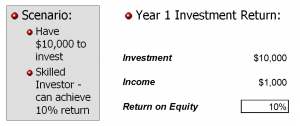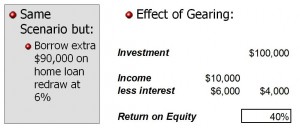USING GEARING TO YOUR ADVANTAGE IN PROPERTY INVESTMENT
For most people, the purchase of an investment property will involve some gearing. Gearing refers to the finance of the investment where part or all of the purchase is funded by borrowing money. As a strategy this can significantly increase the returns you can make from the investment – but it will also magnify your potential losses.
Before you embark on any investment, it is important that you have a good understanding of gearing and how it works. This will help you take advantage of the increased returns and how you can minimise the associated risks involved.
The following illustrations highlight the impact of gearing on your potential investment returns. If I have $10,000 to invest and receive a 10% return, illustration 1 shows the return I can expect – equating to a 10% return on the $10,000 I originally invested.
Illustration 2 shows the impact of gearing where I borrow an additional $90,000 to invest. The end result is a return of 40% on the $10,000 I originally invested.
The key to making gearing work in your favour is that the rate of return on the investment must be greater than the interest cost of the borrowings. In the illustration above, the return is 10% and the cost of borrowings is 6%.
It is also important to understand that the use of gearing also increases the risk involved. Remember the old adage, the greater the return, the greater the risk. While we have increased the return from 10% to 40% we also now stand to lose up to $100,000 if things go wrong rather than just the $10,000 of our own money that we have invested.
Negative Gearing:
Negative gearing describes the situation where the investment is structured in such a manner that the expenses and interest paid are greater than the income generated by the investment. This results in a loss – and a tax deduction.
We saw in the illustration above that to make gearing work in our favour, the return must be greater than the cost. To achieve this with a negatively geared investment, we need to increase the returns by some capital growth. The combined income and capital growth make up the total Return on Investment.
Therefore, the potential for the property to earn capital growth is a major factor in the overall return from the investment. Given that this is an unknown, it can also be a major risk factor. If you have a negatively geared investment, and you do not get any capital growth, you will lose money on the investment.
Our Analysis
If you are looking at an investment property, you need to understand the impact that the capital growth has on the returns you can expect. At ATM Consultants, we can analyse your property investment proposal and show you the impact of the capital growth on your overall returns and risk.


